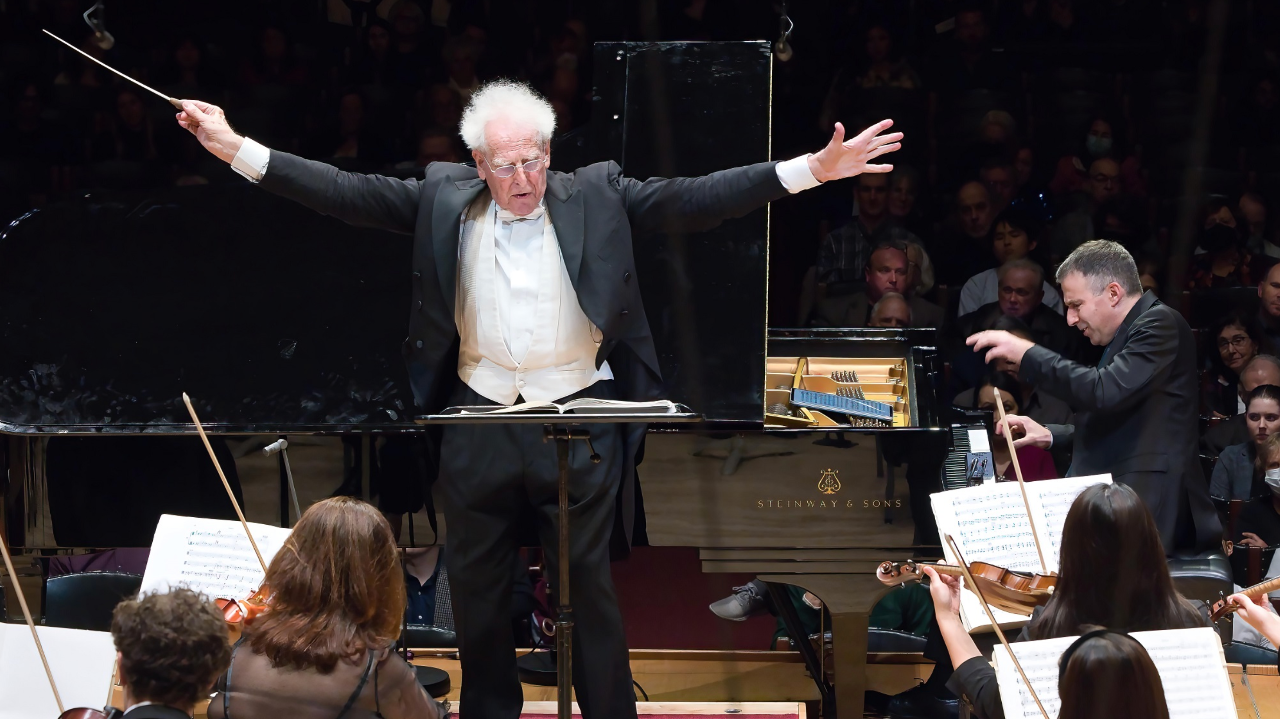Zander leads the Boston Philharmonic in an evening of big works and intense emotion

The Boston Philharmonic Orchestra was back at Symphony Hall Friday night. The dense program focused on mid-20th century music all about men who were really going through it: Britten’s Peter Grimes, beset by society and driven to madness; Bartók, recovering from and ultimately succumbing to leukemia; and Shostakovich in yet another face-off against Stalin.
Conductor Benjamin Zander, in his pre-concert talk, spoke about specifically programming these intense, challenging pieces to speak to each other about the nature of suffering and courage.
The program began with the Passacaglia from Benjamin Britten’s Peter Grimes, a piece that in many ways is a seven-minute embodiment of the opera from which it comes: dark and precarious, but engaging. Principal violist Noriko Futagami took a gentle, steady-handed approach to the opening solo, a voice that’s meant to represent Grimes’ own as he descends into insanity. Between the plaintive violins and the sharp brass the orchestra aptly painted a picture of the character’s unsteady mental state.
Benjamin Hochman was making his Boston debut Friday with Bartók’s Piano Concerto No. 3. Hochman approached the instrument with the ease and cool confidence of a lounge singer about to serenade you, except that serenade was 23 minutes of high musical drama.
Yet Hochman allowed the music speak for itself. He managed to bring out the playfulness of several motifs in the first and third movements despite the overall solemness of the piece. The orchestra itself especially shone during the second movement, meant to illustrate bird songs and forest sounds. The melding of the sparkling strings with the warm brass and woodwinds brought forth the sun peaking through dark trees.
Called back for an encore, Hochman offered Bach’s Sarabande from the Keyboard Partita No. 2 in C minor, rendered with a rapt, almost-holy expression.
Zander and the orchestra tackled Shostakovich’s Symphony No. 10 to close the evening. This massive work simultaneously engages with the ideas of authoritarianism, identity, censorship and death.
Zander chose to match the composer’s prescribed tempo for the second movement, giving it a faster feel and more frenetic energy than how it is typically performed. This was not a bad thing; quite the opposite, as the choice accentuated the conflict implicit in the music. The symphony is not full of memorable tunes but challenges the listener to make sense of the emotions, a challenge that the BPO was fully equal to.
Zander opened the concert with an address from the podium, dedicating the evening to Rosamund Stone Zander, his recently departed ex-wife (with whom he remained close after their separation). “Roz had a profound effect on this institution,” he said. “She was the inspiration and spiritual guide of the BPO since its beginning 45 years ago.” Although the program was full of dark music, he noted, she would have “embraced” the themes of the night, from Shostakovich’s daring to Bartók’s love for his wife, to whom he dedicated the evening’s concerto.
At the end of the evening, Zander and the orchestra showed their love for the departed educator with a moving rendition of “Nimrod” from Elgar’s Enigma Variations. Zander chose a slightly faster tempo for the music, making the elegiac expression clear without excessive sentimentality.
Click here to read the program.
 Maya Shwayder - Boston Classical Review
Maya Shwayder - Boston Classical Review